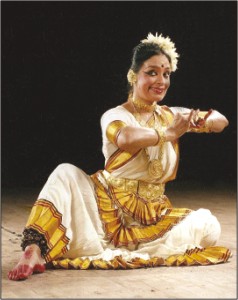Profile
Bharati Shivaji: Revitalising a nascent art form
Kavita Charanji, New Delhi
Indian danseuse Bharati Shivaji lives and breathes the upcoming genre of Mohiniyattam. Tucked away in the verdant environs of the Asiad Village Complex is her Centre for Mohiniyattam where she teaches and undertakes research, documentation and propagation of the dance form. Entering her house one steps into an expansive room where she runs dance classes. Here are musical instruments such as the tabla, veena, mridangam and maddalam. Several traditional mural paintings from Kerala along with metal statues of Natraj and Krishna decorate the room, along with a host of certificates with a photograph of her receiving the Padmashri from President Abdul Kalam. Bharati is acquainted with Bangladesh. In the course of her visit to Dhaka in 2000 she undertook two performances and a workshop. The aim of the latter was to elucidate the finer points of Mohiniyattam, demonstrate the delicate movements and the uniqueness of the dance form. Expanding on this experience, Bharati says, "The workshop went off wonderfully well and the students found it very useful. They asked pointed questions and it went a long way in introducing them to the less known dance form." Together with this, Bharati has choreographed Rabindra Sangeet in Mohiniyattam, which she describes as "well received." In the Bengal chapter of her centre she has trained senior dancers such as Mom Ganguly, Kasturi and Sangeeta, who she says have "matured into seasoned performers." West Bengal has been conducive to her art, she says: "Music and dance are very important art forms in this part of India, largely because of Shantiniketan where Mohiniyattam is taught." Bharati's tryst with Mohiniyattam began in the '70s at a time when there were few exponents for the lyrical and gentle dance form. Realising the infinite potential of Mohiniyattam, at the behest of the late Kamladevi Chattopadhyay she undertook research on this genre under a fellowship scheme from the Sangeet Natak Akademi. For more extensive research she received another senior fellowship from the Department of Culture, an Indian government body. In her dance school Bharati currently has 20 or so students from the age of 12 years onwards. Together with her talented daughter Vijayalakshmi and her troupe, Bharati has been on her toes of late. Among the high points of mother-daughter's dance career is the fusion of Mohiniyattam with western classical music. The outcome: a choreographic composition based on the celebrated Swan Lake, a remarkable composition of the great Russian composer Tchaikovsky. The splendid work has run to full audiences in the course of 24 shows in India. The Mohiniyattam style of Swan Lake has also enthralled viewers further afield in the prestigious Bolshoi Theatre, Moscow and Conservatory Theatre at St. Petersburgh, Russia in 2005. Explaining her fascination with ballet, Bharati notes, "Mohiniyattam has a lot in common with ballet. The costumes in white are to be found in both genres, while the mood is soft, gentle, very lyrical and suggestive." For Bharati, dance is more a passion than just another profession. She has dedicated herself heart and soul to Mohiniyattam, which she describes as "a way of life".
|

|